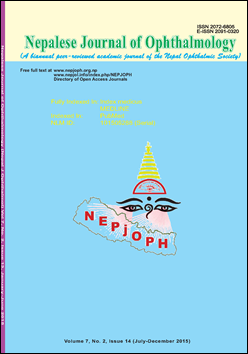Firework-related Ocular Injuries During Festival Season: A Hospitalbased Study in a Tertiary Eye Care Center of Nepal
DOI:
https://doi.org/10.3126/nepjoph.v13i1.31246Keywords:
festival, firework, firecracker injuries, ocular injuriesAbstract
Introduction: Firework-related ocular injuries are an important cause of preventable ocular injuries and are common during the festival season. Despite the strict legislation in Nepal, the use of a firework is still commonly used during Tihar and Chaath festivals. Objective: To evaluate demographic distribution, mode, causative firework, type of fireworks-related ocular injuries, and visual outcome at a tertiary eye hospital in Eastern Nepal. Methods: This is a hospital-based prospective interventional study. All the patients with firework-related injuries who attended the emergency and outpatient department of SCEH, Lahan, during or within 1 month of the festival season (Tihar and Chaath puja) were included in this study. Results: Total of 65 eyes were included. The left eye was involved in 49.1%, 82.5% were males. Mean age of the patients was 15.3±14.7 years (range 5yr – 75yr). Children less than 16 years were predominantly involved (77.2%). Firecrackers (56.1%) were the most common type of fireworks causing injury. The closed globe injuries were more (78.5%) compared to open globe injuries (21.5%). Surgical management was done in 50.9% of cases. Following management visual acuity of most patients improved. Only 8 eyes (12.3%) had visual acuity less than 3/60 after management compared to 28 eyes (43.1%) at the time of presentation.
Conclusion: Firework related ocular injuries are important causes of preventable blindness. A combined approach of public awareness about the possible dangers, preventive measures, early treatment by trained primary ophthalmic care, and implementation of strict legislations are essential to reduce blindness due to this preventable cause.
Downloads
Downloads
Published
How to Cite
Issue
Section
License
This license enables reusers to copy and distribute the material in any medium or format in unadapted form only, for noncommercial purposes only, and only so long as attribution is given to the creator.




